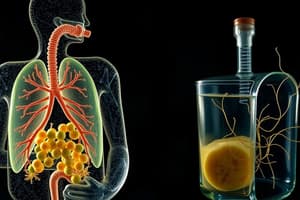Podcast
Questions and Answers
Anaerobic respiration is the more specific and scientific term for anaerobic fermentation.
Anaerobic respiration is the more specific and scientific term for anaerobic fermentation.
False (B)
The main by-products of aerobic respiration are carbon dioxide and ethanol.
The main by-products of aerobic respiration are carbon dioxide and ethanol.
False (B)
Aerobic respiration mainly occurs in lower animals and fungi.
Aerobic respiration mainly occurs in lower animals and fungi.
False (B)
Glycolysis occurs in the mitochondria during aerobic respiration.
Glycolysis occurs in the mitochondria during aerobic respiration.
The Krebs cycle produces 6 GTPs, 6 NADH, and 2 FADH2.
The Krebs cycle produces 6 GTPs, 6 NADH, and 2 FADH2.
Electron Transport Chain produces ATP using the reducing power of NADH and ATP.
Electron Transport Chain produces ATP using the reducing power of NADH and ATP.
Aerobic fermentation does not require oxygen.
Aerobic fermentation does not require oxygen.
Aerobic fermentation is more efficient in energy production compared to anaerobic fermentation.
Aerobic fermentation is more efficient in energy production compared to anaerobic fermentation.
In aerobic fermentation, pyruvate is partially oxidized to CO2 and H2O as organic end products.
In aerobic fermentation, pyruvate is partially oxidized to CO2 and H2O as organic end products.
Ethanol fermentation is an example of aerobic fermentation.
Ethanol fermentation is an example of aerobic fermentation.
Lactic acid fermentation requires oxygen as the final electron acceptor.
Lactic acid fermentation requires oxygen as the final electron acceptor.
Aerobic respiration is more precisely called aerobic fermentation due to the involvement of oxygen.
Aerobic respiration is more precisely called aerobic fermentation due to the involvement of oxygen.
Both aerobic and anaerobic fermentations use fructose as the substrate.
Both aerobic and anaerobic fermentations use fructose as the substrate.
Anaerobic fermentation occurs in both cytoplasm and mitochondria.
Anaerobic fermentation occurs in both cytoplasm and mitochondria.
Aerobic fermentation produces more ATP than anaerobic fermentation.
Aerobic fermentation produces more ATP than anaerobic fermentation.
In aerobic fermentation, glucose is incompletely oxidized into ethanol and lactic acid.
In aerobic fermentation, glucose is incompletely oxidized into ethanol and lactic acid.
Anaerobic fermentation uses oxygen as the final electron acceptor in the electron transport chain.
Anaerobic fermentation uses oxygen as the final electron acceptor in the electron transport chain.
Water is a product of anaerobic fermentation.
Water is a product of anaerobic fermentation.




